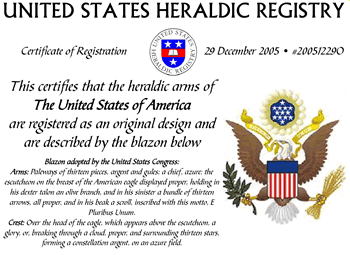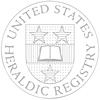U.S. Heraldic Registry
Registration of contemporary and historical American heraldry
The United States of America
Registration number 20060825O
This certifies that the heraldic arms of The United States of America are registered as an original design and are described by the blazon below

Sources
The historical note is quoted from FOTW Flags Of The World website at URL http://flagspot.net/flags/. Original author is Joe McMillan.
Historical note
Immediately after declaring independence on July 4, 1776, the Continental Congress constituted a committee consisting of Benjamin Franklin, John Adams, and Thomas Jefferson to propose a design for a seal for the new United States of America. It was not until June 20, 1782, however, following the fruitless efforts of this and two other committees, that Congress approved a design recommended by its Secretary, Charles Thomson. Following the adoption of the Constitution of 1787, Congress enacted a law confirming this design as the great seal of the United States. The obverse of the seal consists of the coat of arms, which is officially blazoned in the original approving legislation as:
"ARMS. Paleways of thirteen pieces, argent and gules; a chief, azure; the escutcheon on the breast of the American eagle displayed proper, holding in his dexter talon an olive branch, and in his sinister a bundle of thirteen arrows, all proper, and in his beak a scroll, inscribed with this motto, E Pluribus Unum.
"For the CREST. Over the head of the eagle, which appears above the escutcheon, a glory, or, breaking through a cloud, proper, and surrounding thirteen stars, forming a constellation argent, on an azure field."
Thomson's explanation of the symbolism was also approved by the Continental Congress:
- The thirteen alternating pales represents the states,
- Supporting and united by Congress, represented by the blue chief.
- The colors signify purity and innocence (white), hardiness and valor (red), and vigilance, perseverance and justice (blue).
- The olive branch and arrows represent the powers of war and peace.
- The constellation represents a new state taking its place among other sovereign powers.
- The eagle as sole supporter signifies that the United States "ought to rely on their own virtue."
- The motto is translated, "Out of many, one."
Until the late 19th and early 20th centuries, representations of the arms varied according to the government agency using them and the taste of the artist, particularly in the positioning of the wings, head, and legs of the eagle and the interpretation of the crest. In 1885, the Department of State commissioned Tiffany and Company of New York to design and cut a new die for the great seal, which ultimately resulted in the standardization of the arms as used throughout the U.S. government. The artist responsible for this rendering was Tiffany's chief designer, James Horton Whitehouse.
From the late 18th century until after World War I, the coat of arms was the principal charge on colors and standards of regiments of the U.S. Army, and from 1882 to 1916 on the Presidential flag used by the U.S. Navy. It now appears in its entirety on the flags of senior officials of the Departments of State and of the Army and in the canton of the Coast Guard ensign. The coat of arms on the current Presidential and Vice Presidential flags is a variant, which technically conforms to the wording of the legal description of the national coat of arms, but not to the appearance of the Tiffany design used on the great seal.
Sources. Department of State publication, "The Great Seal of the United States," the official history of the great seal, "The Eagle and the Shield," and Elizabeth W. King, "Seals of Our Nation, States, and Territories," National Geographic (July 1946).
Registered by
Michael Swanson
